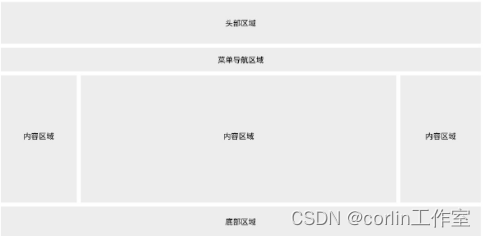css-CSS 网页布局
推荐 原创网页布局有很多种方式,一般分为以下几个部分:头部区域、菜单导航区域、内容区域、底部区域:

1)、头部区域位于整个网页的顶部,一般用于设置网页的标题或者网页的logo。
<style>
body {
margin: 0;
}
/* 头部样式 */
.header {
background-color: #f1f1f1;
padding: 20px;
text-align: center;
}
</style>
</head>
<body>
<div class="header">
<h1>头部区域</h1>
</div>
</body>
2)、菜单导航栏包含一些链接,可以引导用户浏览其他网页:
<style>
* {
box-sizing: border-box;
}
body {
margin: 0;
}
/* 头部样式 */
.header {
background-color: #f1f1f1;
padding: 20px;
text-align: center;
}
/* 导航条 */
.topnav {
overflow: hidden;
background-color: #333;
}
/* 导航链接 */
.topnav a {
float: left;
display: block;
color: #f2f2f2;
text-align: center;
padding: 14px 16px;
text-decoration: none;
}
/* 链接 - 修改颜色 */
.topnav a:hover {
background-color: #ddd;
color: black;
}
</style>
</head>
<body>
<div class="header">
<h1>头部区域</h1>
</div>
<div class="topnav">
<a href="#">主页</a>
<a href="#">产品</a>
<a href="#">关于</a>
</div>
3)、内容区域一般有2种形式;1列(一般用于移动端);2列(一般用于平板设备);3列(一般用于PC设备)。
<style>
* {
box-sizing: border-box;
}
body {
margin: 0;
}
/* 头部样式 */
.header {
background-color: #f1f1f1;
padding: 20px;
text-align: center;
}
/* 导航条 */
.topnav {
overflow: hidden;
background-color: #333;
}
/* 导航链接 */
.topnav a {
float: left;
display: block;
color: #f2f2f2;
text-align: center;
padding: 14px 16px;
text-decoration: none;
}
/* 链接 - 修改颜色 */
.topnav a:hover {
background-color: #ddd;
color: black;
}
/* 创建三个相等的列 */
.column {
float: left;
width: 33.33%;
}
/* 列后清除浮动 */
.row:after {
content: "";
display: table;
clear: both;
}
/* 响应式布局 - 小于 600 px 时改为上下布局 */
@media screen and (max-width: 600px) {
.column {
width: 100%;
}
}
</style>
4)、底部区域在网页的最下方,一般包含版权信息和联系方式等:
/* 底部样式 */
.footer {
background-color: #f1f1f1;
padding: 10px;
text-align: center;
}
更多【css-CSS 网页布局】相关视频教程:www.yxfzedu.com
相关文章推荐
- 编程技术-MATLAB|怎么将散点图替换成图片 - 其他
- 科技-第二证券:消费电子概念活跃,博硕科技“20cm”涨停,天龙股份斩获10连板 - 其他
- 科技-思谋科技进博首秀:工业多模态大模型IndustryGPT V1.0正式发布 - 其他
- 科技-智能井盖传感器功能,万宾科技产品介绍 - 其他
- 科技-专访虚拟人科技:如何利用 3DCAT 实时云渲染打造元宇宙空间 - 其他
- 机器学习-Azure 机器学习 - 使用 ONNX 对来自 AutoML 的计算机视觉模型进行预测 - 其他
- 缓存-Redisson中的对象 - 其他
- 科技-伊朗黑客对以色列科技和教育领域发起破坏性网络攻击 - 其他
- 科技-SOLIDWORKS 2024新产品发布会暨SOLIDWORKS 创新日活动-硕迪科技 - 其他
- 科技-擎创动态 | 开箱即用!擎创科技联合中科可控推出大模型一体机 - 其他
- 科技-亚马逊云科技大语言模型下的六大创新应用功能 - 其他
- 科技-【亚马逊云科技产品测评】活动征文|亚马逊云科技AWS之EC2详细测评 - 其他
- mysql-java八股文(mysql篇) - 其他
- 计算机视觉-计算机视觉与深度学习 | 基于视觉惯性紧耦合的SLAM后端优化算法 - 其他
- c++-【C++】从入门到精通第三弹——友元函数与静态类成员 - 其他
- spring boot-java 企业工程管理系统软件源码+Spring Cloud + Spring Boot +二次开发+ MybatisPlus + Redis - 其他
- 科技-企业财务数字化转型的机遇有哪些?_光点科技 - 其他
- 科技-云计算的大模型之争,亚马逊云科技落后了? - 其他
- c语言-C语言 变量 - 其他
- 物联网-USB PD v1.0快速充电通信原理 - 其他
2):严禁色情、血腥、暴力
3):严禁发布任何形式的广告贴
4):严禁发表关于中国的政治类话题
5):严格遵守中国互联网法律法规
6):有侵权,疑问可发邮件至service@yxfzedu.com
- 编程技术-Bean作用域
- lua-Unreal UnLua + Lua Protobuf
- python-【Python自学笔记】Flask调教方法Internel Server Error
- oracle-node插件MongoDB(二)——MongoDB的基本命令
- 智能手机-手机怎么打包?三个方法随心选!
- 智能手机-香港金融科技周VERTU CSO Sophie谈Web3.0的下一个风口 手机虚拟货币移动支付
- 搜索引擎-外贸网站优化常用流程和一些常识
- 电脑-PHP分类信息网站源码系统 电脑+手机+微信端三合一 带完整前后端部署教程
- 智能手机-手机是否能登陆国际腾讯云服务器?
- 智能手机-GD32单片机远程升级下载,手机在线升级下载程序,GD32在线固件下载升级,手机下载程序固件方法
